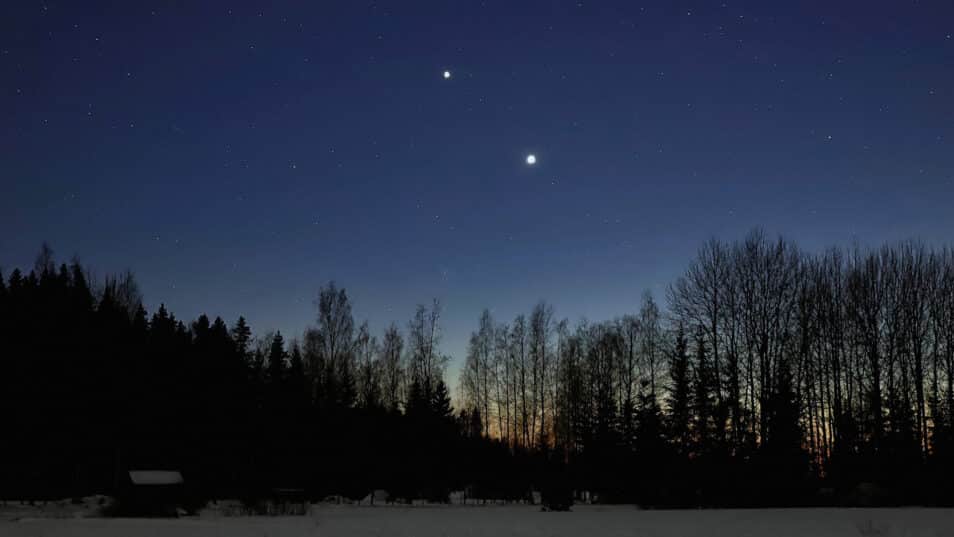Do you see two bright stars above the western horizon? They are not stars, but planets: Venus and Jupiter. Tonight and tomorrow, the two planets seem to be touching.
This week, amateur astronomers and enthusiasts are treated to a lot of beauty. It was early this week northern Lights easy to see in large parts of the Netherlands. Today and tomorrow you can enjoy another beautiful conjunction of the largest planet in the solar system and sister earth.
You don’t need a telescope or binoculars to observe the conjunction of Jupiter and Venus. Look to the northwest between 7 and 8 p.m. and you will see the two planets approaching each other. Extend your arm and you will see that your little finger is placed just between the two planets. The bright planet is Venus. It’s the ball on the right. This may sound strange – because Jupiter is much larger than Venus – but that’s because Venus is closer to Earth. Therefore, this planet appears to be larger.
The faintest ball is Jupiter. This is especially noticeable when looking through a telescope. Next, Jupiter’s cloud bands, the Great Red Spot, and up to four moons can be seen. Visit an observatory near you tomorrow night or Friday if you want to see Jupiter through the lens of a telescope.
From today, the duo will separate and it will take years for the planets to appear closer again. At least, seen from the surface of the earth. In reality, the distance between Venus and Jupiter is currently 700 million kilometers.
Scientists suspect that Venus once had a stable climate. “I am convinced that Venus was once habitable,” researcher Stephen Kane told Scientias.nl. However, Jupiter threw a spanner in the works. The gas planet nudged Venus, sending the planet into a new orbit. As a result, more and more surface water disappeared, leaving an arid and parched world.
Why are Jupiter and Venus close?
As you know, all planets revolve around the sun. One planet is slightly faster than the other. For example, our planet takes 365 days to rotate, while Venus needs 243 Earth days. And Jupiter? A year on this gaseous planet lasts no less than 4,332 Earth days. As a result, the planets are never in the same position relative to each other, which creates particular situations, such as today and tomorrow.
Seen from Earth, it looks like the planets Venus and Jupiter are merging. This is because Earth, Venus and Jupiter are roughly aligned. This can be clearly seen in the image below.
Have you ever taken a photo?
Many photos of the beautiful collaboration are now shared on Twitter, Instagram and other social media. It is cloudless everywhere in the Netherlands. And what’s great is that you don’t need expensive equipment to become an astrophotographer. Point your smartphone upwards and take a photo.
During this conjunction of Jupiter and Venus, you may feel a little excited as everyone shares these types of photos. They’re the best with a hint of dusk, says Govert, and he’s right. pic.twitter.com/YeyRj3j8Jj
— Sam Gerrits (@samgerrits) March 1, 2023
Venus and Jupiter with some of Jupiter’s moons in view. pic.twitter.com/xiCA0lqoCP
— Arie Nouwen (@AdrianusV) March 1, 2023
Jupiter (above) dances with Venus (below) – skylight tourism 😇 pic.twitter.com/qc1xPYjbrS
— Helga van Leur ☀ (@helgavanleur) February 28, 2023
#Venus And #JupiterYou won’t see them any closer than today. In reality, the planets are about 700 million kilometers apart, incredible.
Photo taken from the hotel room #Malta. pic.twitter.com/3cVCtCDbTY— John Lapre (@laprejohn) March 1, 2023
There they are, Venus and Jupiter, almost aligned in the evening twilight. pic.twitter.com/2tNRW3WEaP
— Nadine Boke (@NadineBoke) March 1, 2023
Venus and Jupiter, Veluwe, Netherlands pic.twitter.com/HRL5GvmiCc
—Nico (@bakkernico) March 1, 2023
 DodoFinance Breaking News Made For You!
DodoFinance Breaking News Made For You!


